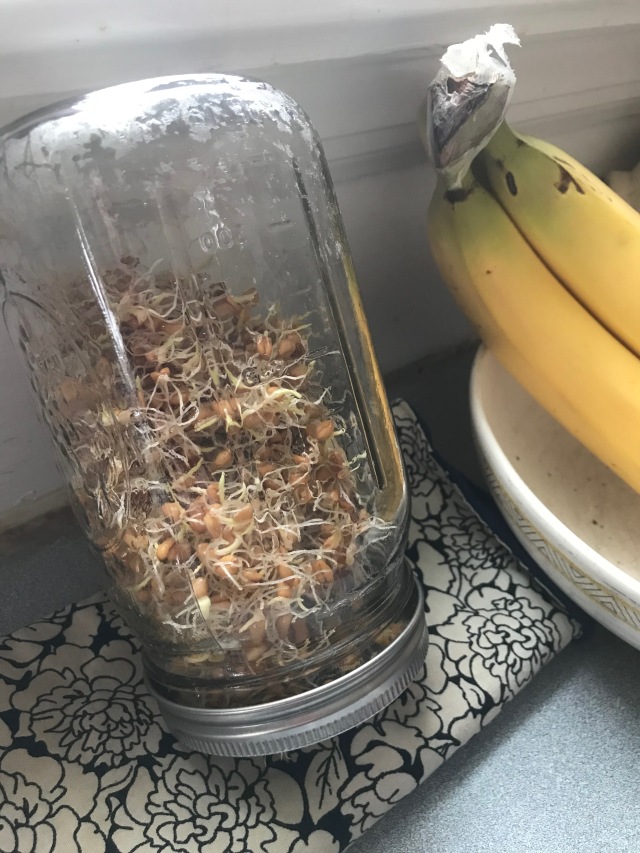I’ve never been the biggest sprouts fan. It’s not that I dislike them. Rather I’m mostly indifferent. Garnishes aren’t really my thing. I’m more of a fill-me-up kind of gal. But I’ve recently learned the error of my ways. They are so easy. And remarkably fast to grow. And nutritious for humans. For example, alfalfa sprouts are a good source of vitamin K and have a bevy of other nutrients. But perhaps what really won me over is that they are tasty greens for my chickens I can grow quickly inside no matter the weather. Quite remarkable. Almost magical, really. Even quick lettuces take about 30 days to mature. Whereas with sprouts I can have greens in less than a week. Once I really grasped that, I was all in.
In the dead of winter when the ground is bare, greens for the ladies are at a premium. I don’t let the ladies free range in the winter because they will destroy anything green, leaving big mud patches in their wake. So sprouts are a wonderful tool in my chicken lady tool belt.
I first considered growing sprouts a few years ago when I came across this book: Microgreen Garden: Indoor Grower’s Guide to Gourmet Greens. I learned a lot from this book but at that point I did not really appreciate the appeal of using sprouts to provide greens for the chickens. So I didn’t take the plunge. The following year, though, I was trying to figure out how to give the girls greens without spending all of my time growing salads just for them. Remembering this book, I started digging around a bit more and what I learned was that sprouts are a wonderful solution.
This is what I do. To start, gather together:
- A wide mouth canning jar like these Ball Quart Canning Jars or other clear container that has an opening you can put a screen over
- Something to use as a screen that will allow water to escape but not the seeds. If you use canning jars these sprouting screens work well.
- Sprout seeds (I like alfalfa for the family and wheat grass for the chickens)
- Water
- A towel to catch small amounts of draining rinse water
I use wide mouth canning jars that a friend gave me when she cleaning out her in-laws cellar. And I use these sprouting screens that are pretty simple and work well for me. When trying to figure out what I needed, I found a lot of different sprouting accessories. I saw whole fancy units designed to grow a lot of sprouts, little metal stands to hold jars at an angle for draining, all sorts of stuff. But I work pretty hard to be as frugal as possible. And after doing this for a while, I really don’t see a need for anything other than a container, a screen, seeds, water and a towel.
Once you have the materials together, place a few tablespoons of the seeds into the container and rinse the seeds a few times with cool water. I use about 3 Tbsp for my alfalfa jar which produces about 4.5 cups of sprouts. About 2 Tbsp of wheat grass seeds in a quart size jar fills the jar.
After rinsing the seeds, fill the jar about ¾ full with water. Cover the jar opening with mesh or cloth or screens. If you use mesh or cheese cloth, make sure to secure it around the mouth of the jar with a rubber band. The screen will need to hold the seeds in the container while letting the water drain away.

Then soak the seeds for about eight hours. If the seeds are bigger, like say wheatgrass, you may want to soak them overnight. The seeds should be about double in size after soaking.
After soaking, rinse the seeds a few times, pour out the excess water and store the jar at an angle that will allow the remaining water to drain out. They sell little stands for this but I just lean my jars against the counter wall and put a towel underneath them.

From there just rinse and drain the seeds twice a day, morning and evening. Three or four times a day is better but not required. You are trying to make certain no bacteria develops. Each type of seed takes a different amount of time to sprout. Smaller seeds are ready faster. My alfalfa seeds usually take three or four days. The wheat grass takes about five to seven days. As soon as you start seeing some green, they are ready to consume.
In the winter, I have been including a healthy handful to the girls’ treats every day. A little more when I don’t have other greens to give them. In terms of what sprout to grow, the opportunities seem to be endless. Wheatgrass, Alfalfa, Broccoli, kale, radish, mung bean, all will work.
I have found sprouts to be a super easy little solution to greens in the winter that can be grown quickly inside. My favorite kind of hack.
